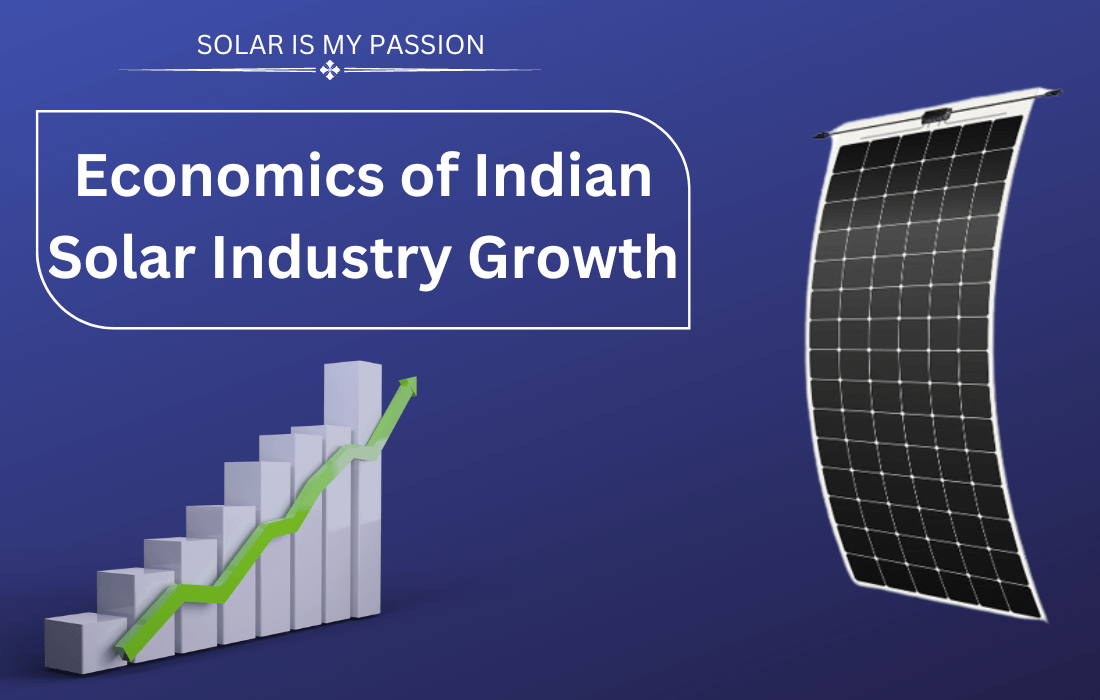In this blog post, we delve into the Economics of Indian Solar Industry Growth, uncovering the factors that have fueled the rapid expansion of this vital sector. Our analysis includes an exploration of market trends, government policies, and investment opportunities, providing readers with a comprehensive understanding of the economic drivers behind India’s impressive solar industry growth. Whether you’re an investor, industry professional, or simply interested in renewable energy, this post is a must-read.
The recently released Indian Economic Survey has devoted a complete section to Sustainable Development Goals (SDGs) and Climate Change, possibly for the first time, demonstrating its growing importance. The section tracked India’s progress on the SDGs, highlighting the achievements of several states, especially SDG 7 on affordable and clean energy. Given India’s track record in renewable energy, the country set a goal of 500 GW of non-fossil-based installed capacity by 2030 at COP26.
According to the UNDP, energy is by far the most significant contributor to climate change, accounting for 73% of all human-caused greenhouse gas emissions. Furthermore, it is vital to highlight that a major section of the population in developing countries’ rural areas lacks access to power.
For example, a village is considered electrified if 10% of the households, as well as public institutions such as schools, the panchayat office, health centers, dispensaries, and community centers, have access to electricity — this essentially necessitates more excellent last-mile solar connectivity, which can be compensated through standalone solar facilities such as rooftop solar and roof streetlights, among others. As a result, utilizing technology such as solar energy will not only help to improve energy availability but will also offer the globe cleaner and more efficient energy.
Indian Solar Industry Emission Trends
India’s CO2 emissions increased to 2,307 metric tonnes (MT CO2) in 2018, compared to 890 MT CO2 in 2000. During this time, India’s emissions climbed at a compound annual growth rate (AAGR) of 5.5 percent, far greater than the global average of 2.1 percent.
A concerning truth is that India’s contribution to global emissions, which was 3.2 percent in 2000, has risen nearly every year since then, reaching 5.7 percent in 2018. Nonetheless, according to the World Bank, India’s per capita emissions in 2018 were much lower at 1.7 tCO2 than the global average of 4.4 tCO2.
India’s Solar dependency on China
India has a fascinating story to tell about the country’s solar energy adoption. According to the International Renewable Energy Agency (IRENA), India’s solar energy installed capacity reached 39.2 GW in 2020, up from 0.1 GW in 2010, with an annual growth rate of about 134 percent. In addition, India’s contribution to global solar capacity has risen from 0.2 percent in 2010 to 5.5 percent in 2020.
However, there is still controversy about how successful indigenous India has been in solar. India has only about 15 GW of local PV module manufacturing capability. Other raw materials, such as wafers, cells, and polysilicon, continue to be a source of competitiveness for India.
India’s reliance on PV cell imports may be seen in the fact that its imports totaled US$ 1.5 billion in 2020, despite a US$ 1.4 billion trade deficit, indicating an 83 percent reliance on China. According to a review of India’s PV cell export competitiveness during the last decade, the situation has gotten worse.
Promoting Solar adoption in Indian Market
While India’s solar energy capacity was at 49.3 GW at the end of December 2021, it was still far short of the National Solar Mission’s goal of 100 GW by March 2023. This would effectively necessitate India rethinking some of its plans in the future.
Given the ever-changing solar business, one of the first issues the sector faces is obtaining financing. The first problem to be solved is in the field of finance. The Covid-19 crisis has strained both the federal and state governments’ resources. As a result, it is critical for government to push new-age instruments to encourage the private sector to invest in solar energy. Green bonds and guarantees, for example, could be among these instruments. Various municipalities in India, such as Ghaziabad Municipal Corporation, which was the first in the country to do so, can also look into issuing green bonds.
Off-grid systems are another opportunity that is mostly underutilized in India. While off-grid technologies are costly, they are essential for universal energy access. Because long-term financing for solar remains a barrier, results-based finance (RBF) may be the key to better off-grid options in India. RBF is a concept focused on completing milestones. In India, the Kerala State Electricity Regulatory Commission issued a Generation Based Incentive (GBI) order in 2014 to encourage off-grid captive solar power plants to fulfill RPO requirements.
In India, the RPO compliance issue is still a problem.
RPOs are likely one of India’s most essential policy tools that can aid the country in meeting its solar energy ambitions. In 2018-19, the Ministry of Power announced a 6.75 percent RPO mandate for solar. With the current orders, the objective for all states and UTs has been set at 10.5 percent by 2021-22. The RPO targets set by state regulatory bodies, on the other hand, show that they are mostly falling short for 2021-22. Only Himachal Pradesh, Jharkhand, Karnataka, Manipur, Rajasthan, and Tamil Nadu have met their targets in accordance with the Ministry of Power’s new RPOs.
Finally, conventional obstacles such as land availability continue to exist in India, despite ongoing improvements. Innovative solutions, such as floating PV, which have proven to be a big success in places like the Maldives, should be investigated to address this issue.
Domestic solar module’s cost price declined by 11%
According to Vikram V, Vice President at research and rating agency ICRA, the cost of modules provided by domestic Original Equipment Manufacturers (OEMs) will drop by 10-11% after April this year, assuming the applicable Basic Custom Duty (BCD) on imported cells and modules.
This is based on a 27 cents per-watt imported Mono PERC module pricing and a 15 cents per-watt cell price. “OEMs using imported cells are still vulnerable to price fluctuations in the cell and module markets,” he noted.
He went on to say that if the price of imported cells and modules falls below the current level, the discount will be reduced.
“From the viability perspective in case of OEMs with integrated facilities, the scale of operations, pace of technology adoption with the emerging trends in key markets such as in China or Europe as well as module price movement remain the critical factors,” he said.
The government’s policy focus on renewable energy remains strong, as seen by the aim of 500 GW of non-fossil fuel-based capacity by 2030 and policy direction in the energy transition, which includes a net-zero emission target by 2070.
Given the relatively reduced execution problems in the solar power segment, capacity growth in the renewable energy industry is likely to remain strong, with roughly 65-70 percent share by 2030.
According to experts, the government has a policy focus on encouraging local solar module manufacture through various policy measures made in the recent 2-3 years.
This includes the notification of an approved list of module manufacturers (ALMM) with effect from April 2021, the imposition of BCD on imported cells and modules with effect from April 2022, the award of manufacturing linked PPAs for a total capacity of 12 GW, and the ongoing implementation of the production coupled incentive (PLI) scheme, as well as the various central schemes previously announced, all of which require the use of domestic modules.
Furthermore, the ALMM list only includes domestic solar OEMs, and the inclusion of foreign solar OEMs is currently dubious.
Because of the positive response to the PLI scheme for solar modules, the scheme’s budget has been expanded to Rs. 240 billion from Rs. 45 billion previously. This is estimated to enable the construction of up to 40 GW of new cell and module manufacturing capacity.


